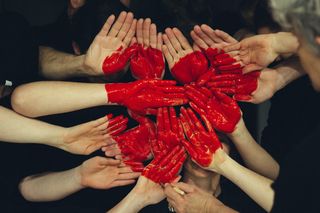Empathy
Moving from Apathy to Empathy
Part 2 of an interview with Belinda Bauman on how we can learn empathy.
Posted July 30, 2019

In part one of my interview with Belinda Bauman, founder of One Million Thumbprints, a movement of peacemakers advocating with women in the world's worst conflict zones, she asserted that empathy can change the world.
In this second half of our conversation, based on her book Brave Souls: Experiencing the Audacious Power of Empathy, Belinda shares how we can move from apathy toward empathy and sit with those in suffering.
What are some practical ways we can move from apathy toward empathy in our own lives?
Since empathy is hardwired into all of us, and we can all get better at practicing empathy—then we must invest in our skills. At a time when so many feel powerless, I found practicing empathy like learning a new habit or discipline so that, over time, we can do something beyond our capacity or power. For those who feel vulnerable, other, bullied or unable to change the circumstances around them, empathy becomes an antidote to powerlessness.
Empathy can become a powerful tool toward fighting against apathy and depression, too. In Brave Souls, I discuss three practical ways empathy can change any relationship. How? Empathy seeks to help people see the world “through…innovative lenses that expand their horizons beyond the often ethno, class, or gender-centric viewpoints” that limit, lessen and impede us from knowing and caring.
One way to see the world better is perspective-taking. What if we could “shapeshift” into someone else? What would we be thinking? Seeing? Hearing? If perspective is nothing more than a fixed point from which you view someone or situation, then perspective-taking means simply assuming someone else’s fixed point—intellectual, emotional, and/or spiritual—without necessarily giving up your own. Sometimes we feel threatened when we’re challenged to take in a view other than our own.
Challenges can leave us stuck, even paralyzed. We stop growing. We become restless. We stop loving. Perspective-taking is a secret weapon against becoming stuck, against defaulting to responses that are less loving and helpful, like apathy, sympathy, or antipathy.
Sometimes called theory of mind, perspective-taking helps us bring out the best in others and stave off a worsening situation. It helps us interpret what others are experiencing in two ways: by opening ourselves up so others can affect us (empathetic receptivity) and by seeing others as agents, or “possibilities,” who can make choices and take action (empathetic understanding). Perspective-taking can help us negotiate, motivate, and activate, and it requires us to be thoughtful and reflective.
Another practical way to learn empathy is through empathetic listening. Someone once said, “Listening is so similar to loving that sometimes you can’t tell the difference.” The human race spends up to 80 percent of its waking hours communicating. We write for about 9 percent of that time, read for around 16 percent. Another 30 percent is spent speaking, but a whopping 45 percent is spent listening. Scientists say the vast majority of that 45 percent is done at an ineffective level. What would happen if we were to convert our everyday listening—45 percent of our total daily communication—into empathetic listening?
Empathetic listening is all about listening to discover what the other person is trying to say—to discover who he really is, not who we think he is, to understand his pain, to isolate his problem, and even to midwife a solution. And more often than we may think, we discover something about ourselves in the process. Everyone is telling some kind of story, from the body language in the checkout aisle to the tone of voice at the dinner table. Empathetic listening learns to focus on others’ voices, their body language, and even their silences by engaging listening practices such as pre-listening, or “reading the air,” around those speaking, and listening "into" rather than listening "at." These tools can become powerful and empowering steps toward healthy and healing empathy.
A third way is through peace-making. Tribalism, whether political, religious, gender-based, or ethnic, has caused much suffering in our world today. However, our need to be a member of a tribe is real, and finding our tribe can be tremendously liberating and energizing. The moments when people echo, “What? You too?” or, “I thought I was the only one,” are the moments when friendships are born.
What advice would you give to help us sit with someone who is suffering?
Sometimes, I wonder why it took a war zone for me to lean in. The particular cauldron of suffering women experience in Eastern Congo can be heartbreaking and overwhelming, even for those listening to their stories. Engaging in another person’s story means sacrificing our own comfort—our privilege actually—and embracing the very real pain of others. But offering empathy and holding space with suffering people requires more than courage. It requires us to genuinely connect. But the more we connect, the more we experience another’s pain. This is where it gets complicated because even though we’re hardwired to engage empathy, we’re also hardwired to avoid pain. The same areas of the brain that control our sense of physical pain switch on when we feel emotional pain, as well. The pain of grief, loss, despair, light up the same centers as a headache or backache. Our bodies economize and reroute all pain to a single neural receptor that detects both emotional and physical pain.
Empathy fatigue is real. So is our ability to consciously turn our empathy off. But there’s good news: everyone has the ability to identify and grow in their capacity to empathize. Much like training for a race, we learn to expect a certain amount of fatigue and pain for the sake of growing stronger and staying in the race longer.
It turns out overcoming our own personal expectations is half the battle. If we think we can offer emotional support and healing through empathy without engaging our own pain centers, we will be disappointed and may even give up before we really start. It’s easy to make excuses or convince ourselves we are overwhelmed and unable to engage. Because genuine empathy requires us to reach into our own experiences and touch, at least in some part, the places we have also suffered, we may be tempted to pull back. When we lean into empathy, we experience our own breakthroughs too, even our own healing. And this is my hope for our future, that brave souls everywhere will take the ultimate risk to love like Esperance—leaning into our own pain, and the pain of others, so that we can all share in the hope that one day we will not only weep with those who weep, but be first in line to rejoice with those who rejoice.




